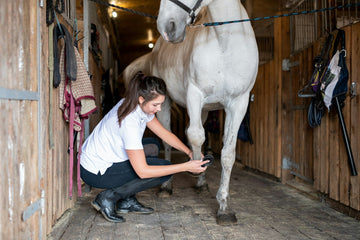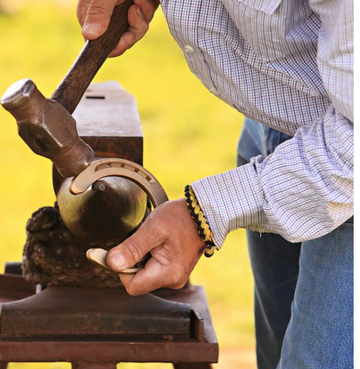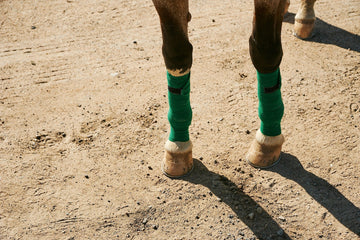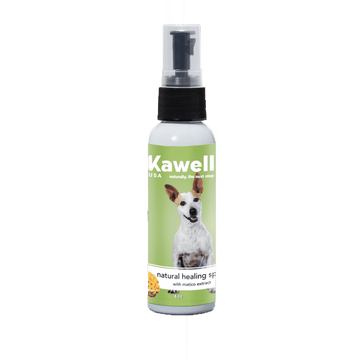Why Proper Horseshoe Care Is Critical for Every Horse
Horseshoes are more than just protective gear—they’re essential tools for supporting hoof integrity, reducing impact stress, and keeping your horse sound and comfortable. However, simply applying a set of shoes isn’t enough. Without the right care and the right materials, horseshoes can become breeding grounds for bacteria, contribute to hoof problems, or wear out prematurely.
Veterinary medicine plays a crucial role in diagnosing and treating hoof health issues, ensuring that hoof care is guided by professional expertise and the latest scientific knowledge.
Proper shoeing practices and the selection of quality materials are essential for enhancing hoof quality, supporting hoof strength, and integrity. Traditional steel shoes may protect hooves mechanically, but they do little to prevent microbial issues like thrush, white line disease, or seedy toe—conditions that thrive in damp, bacteria-rich environments.
This horseshoe care guide will help you understand not only how to maintain and monitor your horse’s shoes but also why, as a horse owner, your active involvement in shoe resetting and overall hoof health management is essential. Innovative options like Kawell USA’s Copper Alloy Horseshoes can significantly improve hoof health for the long term.

Choosing the Right Horseshoes: Why Copper Alloy Matters
Not all horseshoes are created equal. While steel has been the standard for decades, horseshoes are now manufactured from different materials such as aluminum, copper, plastic, and even glue on shoes, each chosen for their unique benefits and specific applications. Common materials for horseshoes include steel, aluminum, copper, rubber, and plastic, with each material offering advantages for different types of horses and activities.
Kawell USA’s Copper Alloy Horseshoes are specifically designed to combat this issue. Made from a patented copper alloy (UNS Alloy No. C6915, EPA Registration #82012-3), these shoes drastically reduce the risk of infections like thrush and white line disease.
Benefits of Copper Alloy Horseshoes
Antimicrobial protection eliminates bacteria and fungus every step your horse takes. These shoes offer durability as copper’s antimicrobial properties don’t wear out with abrasion or tarnish. The shoes are environmentally responsible, crafted from 100% recyclable materials, which helps conserve natural resources and reduces the environmental impact associated with the production and disposal of traditional horseshoes. They offer cost efficiency by lowering long-term expenses through prevention of recurring hoof infections and related veterinary treatments.
These horseshoes offer more than protection—they’re a proactive tool for promoting healthier hooves and reducing the need for reactive treatments.

Benefits of Copper Alloy Shoes for Hoof Balance
Achieving and maintaining proper hoof balance is a key factor in supporting your horse’s overall well-being and performance. Copper alloy shoes offer unique advantages for hoof balance that go beyond what traditional materials can provide. Thanks to their specialized composition, these shoes deliver superior traction, which helps horses maintain a steady, confident stride on a variety of surfaces. This extra grip is especially valuable for horses engaged in demanding activities—whether it’s sport horses navigating tight turns, race horses accelerating out of the gate, or working horses carrying heavy loads over rough terrain.
The lighter weight of copper alloy shoes compared to standard steel options means less stress on the horse’s hooves and legs. This reduction in weight can help minimize fatigue and support the natural movement of the horse’s foot, promoting better hoof balance and alignment. For horses prone to hoof problems or those recovering from injury, this can make a significant difference in comfort and long-term hoof health.
Incorporating copper alloy shoes into your hoof care routine is a proactive step toward supporting healthy hooves, improving hoof balance, and ensuring your horse can perform at its best—no matter the discipline or environment.
Routine Horseshoe Care: Daily, Weekly, and Seasonal Practices
Even with advanced materials, proper care is vital. Regular farrier trims and correct trimming are essential for maintaining hoof health and structure, as they help prevent imbalance, injury, and structural issues. During routine care, farriers assess proper alignment and hoof size to ensure the best fit and support for each horse, taking into account breed, age, and hoof health.
Hoof boots are a versatile form of hoof protection, offering removable support for medical treatment, turnout, and trail riding. They are especially useful for horses needing temporary protection or those transitioning between shoeing cycles.
Here’s a routine that is recommended for horse owners to ensure both the hoof and shoe remain in optimal condition.
Daily Care
Inspect the horse's foot and feet regularly, as regular inspection is essential for overall hoof health. Look for debris, lodged stones, or early signs of thrush or cracks. Clean thoroughly with a hoof pick, especially around the frog and sulci. Check the coronary band for any signs of injury or damage, since this area is critical for hoof wall growth and hoof integrity. Be vigilant for signs of hot nail, long toes, and low heels during your inspection, as these issues can lead to hoof problems if not addressed promptly. Check the shoes for loose nails, uneven wear, or bent edges.
Weekly Care
Condition the hooves with Kawell USA’s Natural Horse Hoof Paste, made with pine oil, pine tar, petroleum jelly, and lard. Weekly conditioning is essential for supporting overall horse hoof health by maintaining moisture balance and preventing common hoof issues. This natural paste maintains ideal moisture levels, strengthens the hoof horn, and discourages fungal and bacterial growth. Wipe down the shoes to remove excess dirt or manure buildup, which can encourage microbial growth even on copper alloys.
Seasonal and Farrier Visits
Schedule farrier appointments every four to six weeks to maintain proper hoof balance and trim. During each visit, farriers assess medial-lateral balance to ensure even weight distribution and proper biomechanics. The needs of shod horses and unshod horses can differ; shod horses may require shoeing for improved traction or therapeutic support, while unshod horses rely on natural hoof wear and may need more frequent trims, especially if living in challenging environments.
Some horse owners choose to keep a barefoot horse or maintain barefoot horses, and in these cases, regular farrier trims are essential for maintaining hoof health and natural movement. For horses prone to thrush, ask your farrier about adding Kawell USA’s Copper Alloy Frog Inserts, which fit into heart bar shoes and specifically target the frog area where bacteria thrive.
Nutrition and Hoof Care: Supporting Healthy Hooves from the Inside Out
Optimal hoof health starts from within. The strength, resilience, and growth of your horse’s hooves are directly influenced by the nutrients they receive every day. A balanced diet rich in essential nutrients is the foundation for a strong hoof wall, steady hoof growth, and overall hoof health. Biotin, a B-complex vitamin, is especially important for supporting the structure and integrity of the hoof wall, while vitamin E acts as a powerful antioxidant to protect hoof tissues from damage. Zinc plays a crucial role in immune function and wound healing, and omega-3 fatty acids help reduce inflammation and encourage healthy tissue development.
For horse owners, providing high-quality hay, grains, and targeted supplements can make a noticeable difference in the quality and durability of their horse’s hooves. Regular trimming and shoeing, performed by a skilled farrier, are equally important for maintaining hoof balance and preventing common hoof problems like cracks, chips, and abscesses. These practices help ensure that the hoof wall continuously grows in a healthy, controlled manner, supporting the horse’s weight and movement.
By prioritizing both internal and external hoof care, horse owners can help their horses develop strong, healthy hooves that are better equipped to handle the demands of daily life, training, and competition. This comprehensive approach not only prevents hoof problems but also supports the overall well-being and performance of your horse, ensuring they remain sound and comfortable for years to come.
Why Copper Alloy Horseshoes Save Money Over Time
Some horse owners hesitate to invest in copper alloy shoes because they cost more than traditional steel. However, when you consider the long-term savings—fewer vet visits, reduced farrier interventions, and fewer lost training days—the value becomes clear. Neglecting proper hoof care can lead to serious health problems, such as lameness, joint issues, and injuries, which increase costs and negatively impact your horse's well-being.
Thrush, white line disease, and seedy toe aren’t just nuisances; they can lead to serious lameness, requiring medical treatment and rehabilitation. By proactively preventing these issues, copper alloy shoes help protect your horse’s health and your bottom line.
Expert Tips for Extending Horseshoe Life
Even the best horseshoes need proper maintenance. Here are a few expert tips to make your copper alloy shoes last as long as possible.
Maintain dry, clean living conditions to prevent prolonged standing in wet, soiled bedding. Regular maintenance of your horses' feet and horse's feet is essential for long-lasting hoof health and optimal shoe performance.
Groom your horse regularly with Kawell USA’s Copper Curry Horse Brush to remove debris that can migrate into the hoof area. Check shoe fit regularly, as poorly fitted shoes wear unevenly and can compromise hoof health. For horses prone to frog infections or deep sulci, combine copper shoes with Kawell USA’s Copper Alloy Frog Inserts for targeted antimicrobial protection.
Many farriers now offer recycling programs for old horseshoes, promoting eco-friendly disposal and helping to reduce waste.
Frequently Asked Questions
How often should I replace or reset copper alloy horseshoes?
Most horses need their shoes reset every four to six weeks, just like with traditional steel shoes. However, hoof size and growth rate can influence how often shoes need to be reset, as larger or faster-growing hooves may require more frequent adjustments to ensure a proper fit. The difference is that copper alloy shoes often last longer and maintain their antimicrobial properties throughout their lifespan.
Do copper horseshoes tarnish or lose effectiveness over time?
Copper tarnishes naturally, but this does not affect its antimicrobial function. In fact, the chemical reactions that occur during tarnishing help generate copper salts, which continue to kill bacteria and fungi.
Can copper horseshoes prevent thrush completely?
While no horseshoe can eliminate thrush on its own, copper alloy shoes drastically reduce the microbial load that contributes to infections. When paired with regular cleaning, frog inserts, and proper stable management, they can prevent most thrush cases.
Are copper alloy horseshoes safe for all horses?
Yes. Kawell USA’s Copper Alloy Horseshoes are EPA-approved and safe for all breeds and disciplines. They’re especially beneficial for horses prone to hoof infections, those living in damp conditions, or high-performance horses needing added impact absorption.
Do I need to use additional products with copper shoes?
While the shoes themselves offer significant protection, combining them with Natural Hoof Paste and Copper Alloy Frog Inserts provides comprehensive defense and conditioning for optimal hoof health.
Conclusion
Horseshoes do more than protect your horse’s hooves—they play a vital role in long-term soundness, performance, and comfort. By following a consistent care routine and upgrading to modern materials like Kawell USA’s Copper Alloy Horseshoes, you can dramatically improve your horse’s hoof health while reducing the risks of thrush, white line disease, and costly veterinary issues.
Pairing these innovative shoes with products like Natural Hoof Paste, Copper Alloy Frog Inserts, and proper daily care creates a holistic approach to hoof maintenance. With the right tools and attention, your horse’s hooves can remain strong, healthy, and ready to perform in any environment.










